The Energy Performance of Buildings Directive (EPBD): A Game-Changer for European Building Sustainability With Stephen Barrett of the IGBC
- Jackie De Burca
- July 25, 2025
The Energy Performance of Buildings Directive (EPBD): A Game-Changer for European Building Sustainability With Stephen Barrett of the IGBC, S4, E16 - article & podcast
LISTEN BELOW TO THE FULL EPISODE
The Energy Performance of Buildings Directive (EPBD) is a European Union directive focused on improving the energy performance of buildings.
It aims to reduce energy consumption and carbon emissions from the building sector by setting standards for new and existing buildings, promoting renovations, and encouraging the use of renewable energy sources.
The recast EPBD, which came into effect on May 28, 2024, introduced stricter requirements for building renovations and aims to achieve a zero-emission building stock by 2050.
The revised Energy Performance of Buildings Directive (EPBD) in Europe sets key dates and deadlines for improving building energy performance and reducing emissions.
A key date is May 29, 2026, when EU Member States must transpose the new rules into their national laws. This includes requirements for zero-emission buildings, renovation of commercial buildings, and other measures to decarbonise the building sector.
“The race to reduce carbon in construction has officially begun. This episode is your roadmap to understanding how the EPBD and lifecycle assessment will reshape the industry—one building at a time.”
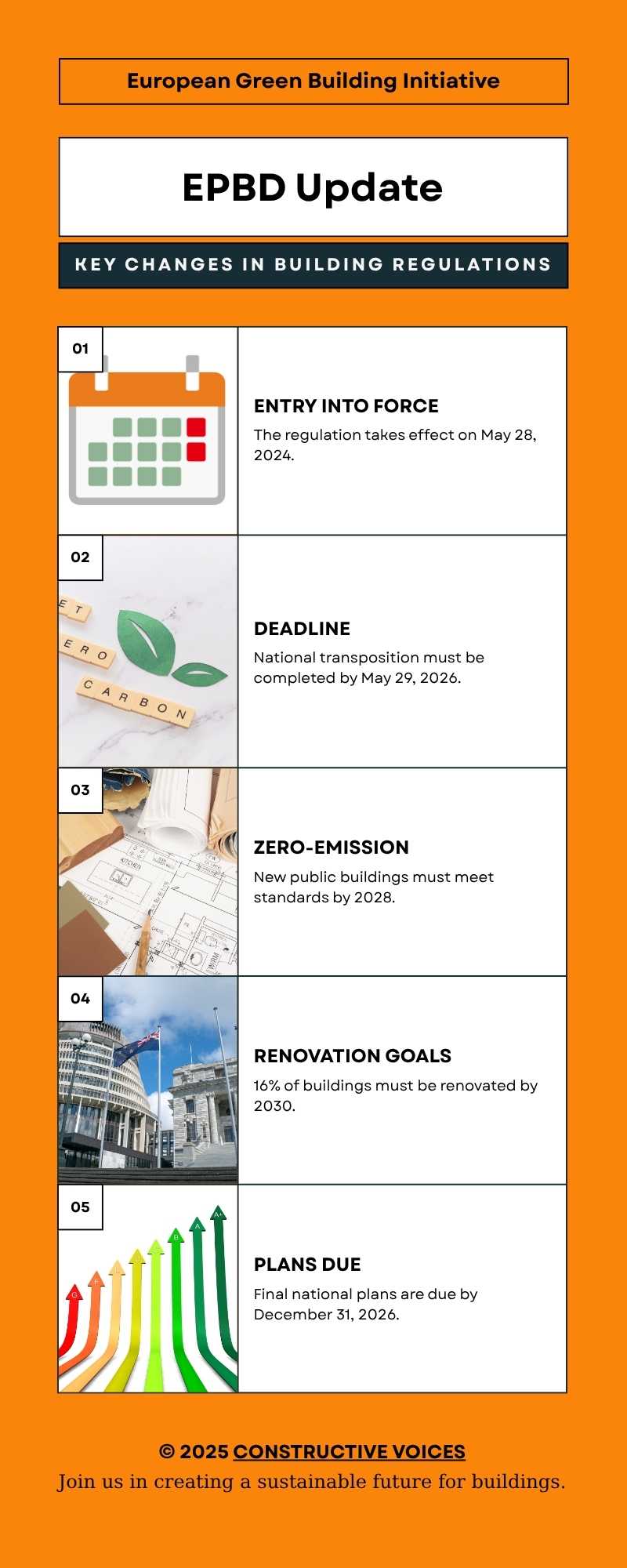
Is Europe on the cusp of a green building revolution? Find out in this podcast episode.
In this episode of Constructive Voices, we’re joined by Stephen Barrett, the driving force behind Ireland’s transition to whole-life carbon assessment in construction.
As Programme Manager at the Irish Green Building Council (IGBC), Stephen is at the heart of implementing the updated Energy Performance of Buildings Directive (EPBD)—a policy shift that’s set to transform how we design, construct, and assess buildings across Europe.
Whether you’re a building designer, material supplier, or policy watcher, this is the insight you need to prepare for what’s coming.
"It's not going to be business as usual..." Tune into the 2-minute excerpt
Who Should Listen?
Architects, engineers & building designers
Construction managers & BIM specialists
Sustainability officers & ESG consultants
Policy makers & local authorities
Students and educators in built environment studies
“Don’t worry about the result—just begin assessing. It’s the act of questioning your design that starts to change behaviour.” — Stephen Barrett, IGBC
What You Will Learn
What the updated EPBD really means—and why it’s a “starting gun” for industry change.
Why lifecycle carbon is overtaking energy as the key metric in building performance.
The vital role of BIM (Building Information Modelling) in meeting new EU carbon targets.
Open source vs proprietary BIM platforms: How to start now, without breaking the bank.
Lessons from the Nordics, and how Ireland’s ahead of the curve with its prototype methodology.
What the construction industry must do before 2030 to stay compliant and competitive.
Why your old tools won’t cut it anymore—and how new platforms like One Click LCA are changing the game.
Simple advice for professionals: Start assessing now—don’t fear the results.
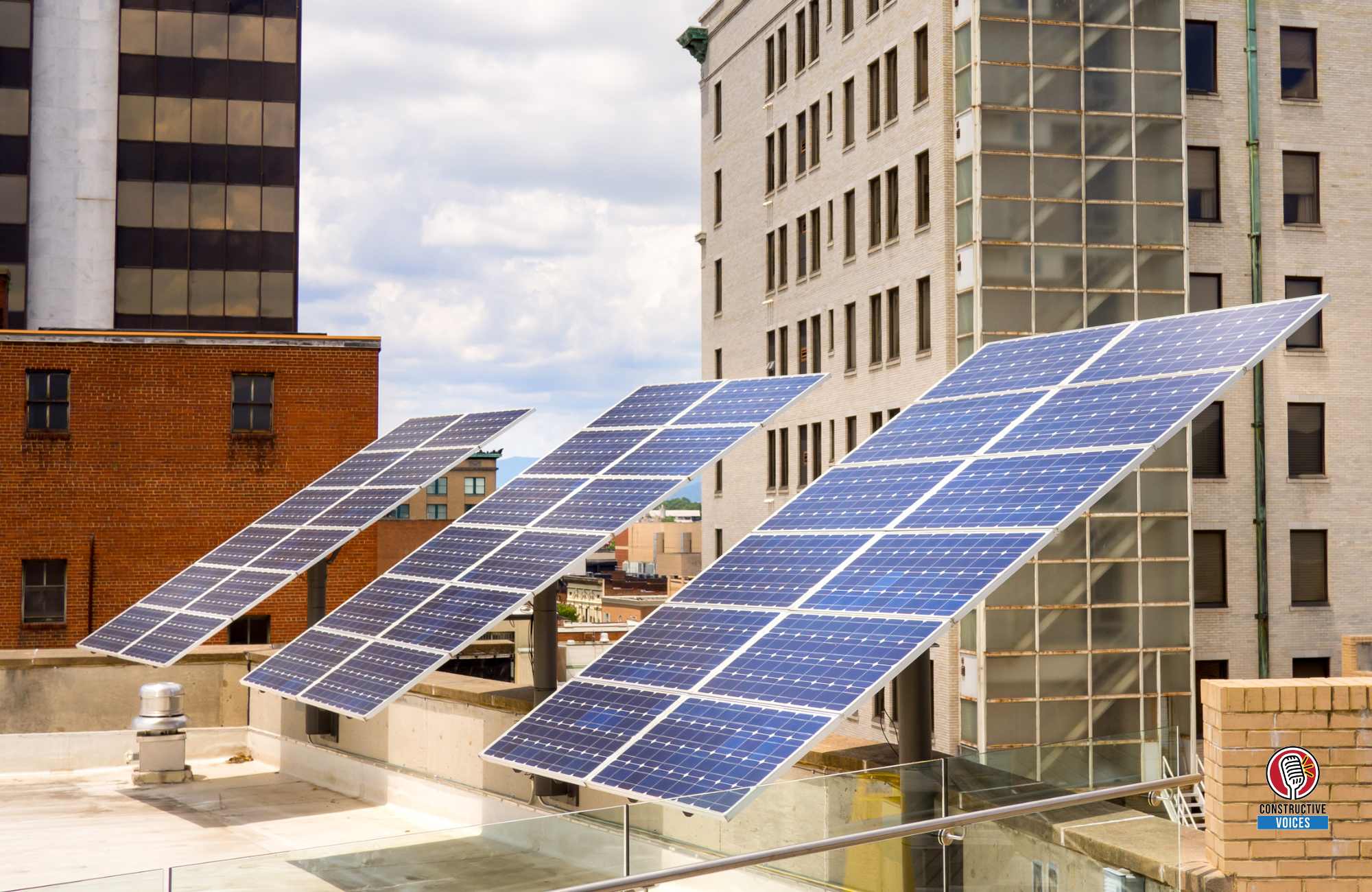
1. Why it matters
Buildings are responsible for around 40% of the EU’s energy use and emissions, with over 85% constructed before 2000 and 75% performing poorly
The EPBD is integral to the Fit for 55 package, aiming for a net-zero, climate-neutral building stock by 2050
Benefits: Lower energy bills, enhanced energy security, job creation, cleaner indoor environments, and strengthened EU competitiveness
2. Key provisions in the recast EPBD
A. Zero-emission building (ZEB) standards
From 1 January 2028, all new public buildings must be ZEB. By 1 January 2030, this extends to all new residential and commercial buildings.
‘Zero emission’ means very high energy performance + no fossil-fuel emissions + on-site renewables.
B. Minimum Energy Performance Standards (MEPS) & renovation targets
Member States must establish national renovation plans—home energy consumption to drop by 16% by 2030, 20–22% by 2035 compared to 2020
For non-residential buildings, the worst-performing 16% must be updated by 2030, and 26% by 2033.
C. Lifecycle carbon & embodied emissions
The EPBD now mandates whole‑life carbon assessments, including embodied carbon, which accounts for 10–20% of total CO₂ emissions.
Support tools like building passports, new generation EPTs, and carbon data exchanges are being rolled out—WorldGBC and BPIE have published fact sheets to support implementation.
D. Digitalisation & smart readiness
Enhancements include smartness indicators and systems (e.g., BACS), mandatory solar readiness and EV charging infrastructure in new builds.
E. Financing, technical assistance & one-stop-shops
The Directive mandates accessible funding mechanisms—e.g., mortgage portfolio standards, one-stop renovation shops, advisory tools.
The EPBD.wise initiative supports implementation in six EU countries, helping authorities apply the Directive practically.
3. Challenges & critiques
The biggest challenge for countries implementing updated EPC requirements is balancing immediate actions with long-term sustainability. Many Member States face a lack of technical expertise, trained auditors, and funding.
Some analysts argue it lacks strong fossil-fuel boiler phase-out timelines, postponing bans until 2040, potentially weakening the impact.
4. Why retrofit is crucial
With 80% of 2050 buildings already built, retrofitting is essential.
Studies show current renovation rates (~1%) are far below the 3% per annum needed to meet Paris Agreement goals.
The Directive’s renovation boost, MEPS, digital tools, and financing structures aim to reverse this underperformance
5. Implementation timeline at a glance
| Element | By 2026 | By 2028 | By 2030 | By 2033 | By 2035 | By 2050 |
|---|---|---|---|---|---|---|
| Transposition into national laws | ✓ | |||||
| Zero-emission public buildings | 1 Jan 2028 | |||||
| Zero-emission all new buildings | 1 Jan 2030 | |||||
| Home energy use reduction | 16% reduction | 20–22% reduction | ||||
| Non-resi worst 16% renovated | ✓ | |||||
| Non-resi worst 26% renovated | ✓ | |||||
| Cost‑optimal method set by EU | June 2025 | |||||
| Full decarbonisation of EU building stock | ✓ |
"Building a Sustainable Future-The Need for a Clear Framework.." 2-minute excerpt
6. What can enhance the EPBD’s impact?
Digital & data tools: Renovation passports, certificates, building logbooks—unlocking asset-level carbon planning.
Financial mechanisms: Mortgages tied to energy performance, EU funds, subsidies, targeted support against energy poverty.
Smart and renewables readiness: Homes built to integrate PV panels, heat pumps, EV charging.
Skilled professionals: Certification rules for expert assessors, one-stop shops and capacity building for local authorities.
“If we design with carbon in mind from the beginning, we won’t just build better—we’ll change the entire supply chain behind construction.”— Stephen Barrett, IGBC
About Stephen Barrett
Stephen joined the Irish Green Building Council (IGBC) in 2020 and is currently Programme Manager for Whole Life Carbon initiatives.
He has contributed to several key European and national projects, including Level(s) – the EU framework for measuring the environmental performance of buildings – and the #BuildingLife campaign, aimed at aligning public policy and industry practices with Whole Life Carbon (WLC) goals.
Stephen led the UPFRONTCO2 and INDICATE projects and is currently managing IMPLEMENT, which focuses on mainstreaming WLC approaches.
He holds an MSc in Sustainability and Adaptation in the Built Environment and brings a strong background in data management, analysis, and visualisation.

The Irish Green Building Council’s work on carbon emissions & LCA , includes the lifecycle assessment methodology developed through the INDICATE project and other resources on whole life carbon: IGBC Carbon & LCA Projects
In 2024, during World Green Building Week, the IGBC hosted a tour of Cobh, which really highlighted the role of Tidy Towns and community-led action.
Explore more about this below:
IGBC hosts week of events focused on climate action and nature-positive design
About The Irish Green Building Council
The Irish Green Building Council – IGBC, is a non-profit organisation that was launched in 2011 with organisations and businesses from across the value chain of the built environment.
These include architects, engineers, contractors, universities, professional institutes, NGOs, local authorities, energy companies, leading national and transnational companies.
All are united in one common goal to accelerate the transformation of the built environment to one that is sustainable through leadership, research, education, and providing policy input to national and local government.

The Irish Green Building Council aims to:
- Provide a source of leadership for sustainability and quality in the built environment
- Promote and assist in the provision of credible metrics for measuring progress towards the end goal of sustainability
- Provide a source of resources to companies transitioning their activities towards more sustainable practices
- Be central to the alignment of the policies of organisations seeking to achieve sustainability in the built environment
The Irish Green Building Council (IGBC) is leading Ireland’s implementation of the updated Energy Performance of Buildings Directive (EPBD), with a strong focus on whole life carbon assessment.
As part of this, the IGBC is collaborating with the Sustainable Energy Authority of Ireland (SEAI) to develop national methodologies, digital tools, and educational resources—ensuring industry professionals are equipped to assess and reduce embodied carbon.
Through pilot projects, training, and open-source BIM initiatives, the IGBC is positioning Ireland as a proactive player in Europe’s transition to a low-carbon built environment.
Related Podcasts Not To Miss
Why Nature Credits Matter – With Brian MacSharry, European Environment Agency
Why Nature Credits Matter – With Brian MacSharry, European Environment Agency Unpacking how nature credits could reshape the way...
- Jackie De Burca
- September 29, 2025
What is the European Commission’s Roadmap towards Nature Credits?
What is the European Commission’s Roadmap towards Nature Credits? “When I first saw the news of the EU’s Roadmap...
- Jackie De Burca
- September 28, 2025
Ireland’s Retrofit Race — with Dr. Ciarán Byrne (SEAI)
Ireland’s Retrofit Race with Dr. Ciarán Byrne (SEAI) How Ireland is making homes warmer, cheaper to run, and lower-carbon—at...
- Jackie De Burca
- September 12, 2025
Good News: A New Way To Look At Sustainability & Pocket Forests & Retrofitting in Ireland
Good News: A New Way To Look At Sustainability & Pocket Forests & Retrofitting in Ireland In this uplifting...
- Jackie De Burca
- August 14, 2025
A Sustainable Snapshot of Cobh: Local Action, Global Implications S4, E14
A Sustainable Snapshot of Cobh: Local Action, Global Implications S4, E14 “I just hope all this new development is...
- Jackie De Burca
- July 11, 2025
Greening Ireland: From Pocket Forests to Native Woodlands With Catherine Cleary,S4, E11
Greening Ireland: From Pocket Forests to Native Woodlands With Catherine Cleary ‘Greening Ireland: From Pocket Forests to Native Woodlands...
- Sarah Austin
- June 2, 2025
Life Inside Cloughjordan Ecovillage – A Blueprint for Sustainable Community Living – Podcast Episode: S4, E6
Life Inside Cloughjordan Ecovillage – A Blueprint for Sustainable Community Living Life Inside Cloughjordan Ecovillage – A Blueprint for...
- Sarah Austin
- March 24, 2025
S3, E5 Dr Ciaran Byrne, Director, S.E.A.I. on Ireland’s Retrofitting Success Stories, Challenges & Opportunities
S3, E5: Dr Ciaran Byrne, Director, SEAI on Ireland’s Retrofitting Success Stories, Challenges and Opportunities In this enlightening episode...
- Jackie De Burca
- June 11, 2024
Transcript
This is digitally generated so may contain some errors.
Jackie De Burca: Hi, this is Jackie Burca for Constructive Voices, and today I’m with Stephen Barrett, who you may have heard speaking about Cobh and Cork, and Ireland I suppose to some extent in the last episode.
Now, Stephen is the program manager, whole life carbon lead for the Irish Green Building Council, and he’s very involved in the specific. Project at the moment, which is EU related and obviously very exciting for the times that we’re living in. Stephen, thank you so much for taking the time again to speak to me today.
Stephen Barrett: It’s nice to be here.
Jackie De Burca: Thank you.
Stephen Barrett: I’m Stephen Barrett. I’m the whole life Carbon program manager at the Irish Green Building Council. I joined four years ago and I’ve spent all of that time trying to drive the agenda on more carbon efficient buildings.
Jackie De Burca: Fantastic. Now, [00:01:00] can you give our listeners, Stephen, a brief overview of what you call EPBD, which stands for Energy Performance of Buildings directives?
Stephen Barrett: Yes. So the energy performance of buildings directive is the EU directive that really is responsible for your. Energy performance certificate. So in Ireland, that’s the Building Energy Rating System. We have the Building Energy Rating System as a direct response to the EPPD. It was updated last year. The EPPD was updated, so we now have more obligations to fulfill over the next three years.
The energy performance that people are familiar with. You know, the A to G rating system of how a building operates. Is changing. The thrust of the EPBD is moving away from just energy and more to emissions. One part of it that we’re gonna [00:02:00] explore in more detail is this lifecycle GWP assessment where mm-hmm.
Instead of, or rather, as well as the operational energy requirement of your building. There’ll also be a requirement to quantify the whole life, the lifecycle carbon emissions of the building, which is pretty complex. So I think that’s what we’re gonna talk about mainly now.
Jackie De Burca: Sure. Yeah, absolutely. Do you feel Stephen EPBD could spark a design revolution in the built environment?
Stephen Barrett: Yes, I think it can, and I think that’s what it’s designed to do. There’s something that’s not really understood with lifecycle assessment is how it doesn’t just affect the individual building. What it does is it signals to building material suppliers that you want different materials to build your building from.
So that means that manufacturing processes change, [00:03:00] that people actually question. More about how they source products. And so when you question how you source it, then the supplier, uh, in order to maintain their market share or increase tries to then promote their. So it’s kind of the way of looking into the factory, if you like, of your building rather than just looking at the cost of the products that you’re getting.
But yes, I think it definitely does have the potential, if it’s implemented right, to drive building designers to look at different ways they construct buildings and the materials that they construct them from.
Jackie De Burca: It’s obviously huge and I remember when we did our research conversation, you mentioned that really the penny hasn’t dropped yet across Europe and you know, there’s a lot of key challenges.
Stephen, what do you feel that those are mainly?
Stephen Barrett: Yeah, so what we’re seeing in other countries, [00:04:00] countries that are further down the road is that the building designers are looking at making the building not just more efficient in operation, but more efficient in material. And that material being sourced more carefully.
So it’s not going to be business as usual for so many people in the industry, from the designer to the manufacturer, to people deconstructing buildings because used materials should have a greater value than they currently do. So I think the supply of materials. Is going to change a lot. People are currently just measuring or trying to get to grips with what is the carbon emissions associated with my concrete?
But once we have a body of knowledge and people with expertise in that area, we’re gonna start saying, how can we change it? How can we reduce it? [00:05:00] And that has that knock on effect to everybody else in the industry. I don’t think that’s been realized yet. People currently are just trying to figure out how to do it.
And what are my numbers for my building? But when we start seeing it on more general scale, then we’ll start seeing industries around it trying to supply better information. And in order to supply better information, they’ll want to be improving their processes so that the information is not only good in terms of the quality of the information, but the values that their clients want to see.
Jackie De Burca: Right. I mean, it’s a very complex topic to, to say the least again, but one of the things that you did mention previously is the need for BIM models to meet these kinds of demands. How prepared are the design and construction professionals do you think, for that transition?
Stephen Barrett: So one thing with doing a lifecycle assessment of a [00:06:00] building before the building is built is you need to really kind of plan the scenario.
Mm-hmm. How you expect this building to be for the next 50 years or whatever it is. Not only do you need more information about the products in your building, you also need information about how it’s going to. Perform, perform over its lifetime and what you’re going to do with it at the end of its lifetime.
So these things just aren’t thought about at all at the moment. Currently, we just think about costing. Where BIM comes in is it should, it should give us more accurate design models and all of the information around those designs in a lot more detail than we currently do. IGBC are investigating how to make this as easy as possible and as low cost as possible.
We’re looking at IFC Industry Foundation class as a way of different BIM [00:07:00] softwares talking to each other. One thing that I’m finding is a lot of pushback saying that we just don’t use bim. We do drawings, but we don’t use bim, and it seems to me. That that is the same argument as saying we use pen and paper and not computers.
We don’t right now, but as we learn the benefits, we start to look at new technologies and I think the EPBD is going to push people more towards BIM as a result of not just this, but certainly this will be a big part of it.
Jackie De Burca: Certainly to do those type of calculations that no one in the industry is right now doing, you know, that’s not a design job, is it?
Stephen Barrett: No. We did prototype project using Excel spreadsheets, trying to quantify bills or quantities in Excel and do all the calculations on that, and it was. Very slow, very [00:08:00] painful. But the reason was because we were starting from scratch with the only tools that we had available at the time. We learned a lot from it.
One thing that we learned was if people are prepared in advance, as in told, you are going to need this information at this point, then it’s not so arduous. It’s just another. Part of the design process. It’s only when you try to do it from scratch on a building that you’ve already finished. It’s really difficult.
But if you’re doing it as part of the design process, it can be an aid to design. It can help you understand. Where you can be more efficient, not just in terms of carbon, but in terms of materiality. If you’re using less material, you have less cost in the form of your building. If you can simplify a building, again, it doesn’t just reduce your carbon, it will reduce your operational costs and your [00:09:00] maintenance costs.
Doing this kind of assessment, it’s not just about. A regulator forcing you into doing something for the sake of their reporting requirements. It can help you save costs and add value to your building throughout its lifecycle, not just the capital cost of building it, and then whether it’s for speculative sale or rental or whatever, there’s more value in it there.
Jackie De Burca: Definitely. I suppose what comes into my mind, Stephen, is younger people. That we spoke about briefly in the other episode. You know, they’re going to look at a house or an apartment or an office that they intend to rent or buy, and they’re gonna have all this information upfront about, okay, the price of the property is this, or the rental price is that, but this is what you’re gonna spend on energy each year to run it, you know, for X amount of people.
Or I assume it’ll be like, you know, there’ll be a level of. The building itself, but also the [00:10:00] inhabitants, I suppose.
Stephen Barrett: Definitely a well designed building and certainly an energy efficient building can command a higher rental premium. Taking the time to take these things into consideration at the beginning can have a massive cost benefit as well as the carbon benefit.
If you are able to demonstrate to a potential tenant that they’ll be paying much less in their energy bills. Then you can charge a premium for your rental.
Jackie De Burca: That’s it. It, it’s the same when it comes to biodiversity. You know, I’ve had this conversation with other experts. If the place has lots of beautiful nature, well, you’re talking about an upmarket place straight away.
Stephen Barrett: Yeah, absolutely. And I think a lot of clients, tenants, businesses are recognizing these things are important to their workforce, so being able to provide your workforce with a better environment definitely attracts employees that you want there.
Jackie De Burca: What would you say are [00:11:00] the limitations of relying solely on the old ways versus how BIM can improve both compliance and performance?
Stephen Barrett: So relying on the old ways, you’re going to be doing your calculations very slowly. Cross-referencing numbers that will drive you crazy. When we at IGBC are looking at open source free bin where you can attach all of this data to a model. On in the design phase so that as you design, you are getting feedback.
If you stick with the old ways, you will have to do a design, assess it, do another design, assess it, and it will just be long and painful. We’re looking at ways that you can, we put the numbers into the design as the design evolves, so you can change a wall, remove a wall, you get an instant change in the numbers that Lee is asking for.
So. If you stick with the old [00:12:00] ways, you’re just going to be iterating very, very slowly. If you move over to bim, the way I see it is you can, then it becomes a design tool for all the other benefits, not just your carbon figures being low as possible.
Jackie De Burca: And I love the fact that I latched onto one word is open source and obviously the other word being free.
You know, open source for people who don’t understand that is the fact that, you know, it isn’t, I’m not gonna name any brand names, so it’s not ma name made by a particular brand and therefore can’t be changed. Basically means that people who are technical enough can go in and improve the system and it’s free.
Isn’t that right?
Stephen Barrett: There’s a particular open source platform that I always push. I don’t know if I can mention it here. There’s an open source BIM called Bonsai bim. If you go to bon side bim.org, you can download the whole BIM software there and start designing straight [00:13:00] away. You can also create add-ons to it because it’s open source.
Jackie De Burca: Fantastic.
Stephen Barrett: And if you’re technically capable, anything that you can dream up, you can add onto it.
Jackie De Burca: Fantastic. So I’m gonna assume that’s bonsai, like the, like the trees? No. Yes, yes. B for Bertie, O for orange, N nothing. S for sugar, A for apple, I for Ireland. That wasn’t the best phonetic alphabet, but that’s how it’s spelled, isn’t it?
Yes. Fantastic. Fantastic. That’s great. Now going on to article seven of the EPBD, why do you describe its publication as a kind of a starting gun?
Stephen Barrett: It is a starter again, because we’ve got a timetable between now and the 1st of January, 2030 to by the 1st of January, 2030, we should be calculating and disclosing lifecycle carbon for all buildings, all new buildings.
I’m not sure if [00:14:00] it’s going to apply to renovations yet, but definitely all new buildings by the end of. Next year, 2026, we need to be feeding back to the European Commission on a roadmap that details limit values. That means saying to the EU by 2030, we will be stipulating that no building can have a carbon footprint of x.
Kilos of CO2 per square meter, and then by 2032 it will be a lower figure, and by 2034 it will be a lower figure. So it’s about the first thing we need to do is establish that trajectory. To do that, we need a method for calculating the numbers that feed into that trajectory. In 2028, we’ll start measuring buildings over a thousand square meters.
So any. Building application over a [00:15:00] thousand square meters would need a lifecycle assessment done on the design. Uh, by 2030, that’s gonna apply to all buildings. So, uh, it’s a start to gun on how we quantify carbon emissions, not just the operational emissions that we always have done, but the building itself for Ireland.
This is primarily currently. Concrete and steel, the things that affect that figure the most. So we’re gonna start looking at that
Jackie De Burca: now when the day arrives. Stephen, how do you anticipate the industry will respond once you know the specs are kind of formally published?
Stephen Barrett: I think industry will be. I think there’ll be an array of responses, but I think a lot of people really want this.
They want clarity. People have been doing lifecycle assessments in their own ways for a few years now, but they all differ. [00:16:00] Everything around the calculation differs, meaning it’s really difficult to compare to people’s figures. So two people’s results, it’s almost impossible to tell which is the better in inverted commas building.
When people have assessed in completely different ways, so people are already interested in it, but there’s no consistency, I think this will bring consistency and hopefully it will bring the right tools for doing it as easy as possible. It will give us a kind of a stable platform to work on that we currently don’t have, and I think industry is ready for that.
I think building designers want to do the right thing. I think clients want to do the right thing. They just don’t know what the right thing is yet, because we don’t have a framework to work in, this is going to give us that.
Jackie De Burca: Okay, fantastic. Obviously it’s hugely important to arrive at that point. Now, are there any tools or platforms that [00:17:00] you feel are doing a particularly good job of cutting through that noise?
Stephen Barrett: Do you want me to mention? Yes. Businesses
Jackie De Burca: you’re allowed to. Um,
Stephen Barrett: it’s very hard to argue with OneClick, LCA Who are the market leaders in Europe at the moment? What do you like,
Jackie De Burca: what do you feel, you know, is good about OneClick LCA?
Stephen Barrett: They are always innovating. They’ve, they’re always bringing out new tools to make the job easier.
I was just on a call with them yesterday where they were launching more tools to help you look at your building at the earliest possible stage. So just kind of how big is my building gonna be? What’s it going to be made of helping you estimate the materials that that’s going to require, and therefore the emissions involved in the manufacturer of those materials.
And this is, you know, literally a kind of a, it’s like a five minute back of an envelope sketch of a building, but the tools that they offer just make it [00:18:00] incredibly easy. There is a bit of a steep learning curve, but once you’ve done it, it’s, I think they are by far the most advanced in Europe on this.
Jackie De Burca: Okay, so yeah, we have an episode with Panu Pasanen who is the managing director of that company. So let’s just talk about Ireland now. You’re currently working with the Sustainable Energy Authority of Ireland, s se, ai, to implement these requirements. What are the top priorities, Stephen, in your role?
Stephen Barrett: The top priorities really had to figure out where we are.
The first priority is to learn from other countries, so the Nordics and France kind of further down the road on this. So trying to figure out what has worked in those countries and what the challenges were. That’s the first thing. The next thing is nail down that methodology that meets the requirements of the EPBD.
So what exactly is the calculation that needs to be [00:19:00] performed before the building is built in order to, uh, fulfill the requirements of EPBD that needs finalizing when that is finalized? We also need tools to make it as easy as possible to do that. So the things that OneClick currently offer. If you have a one click license that make life easier, how can we create tools that do a similar thing for, for everybody?
You know, for smaller businesses that don’t necessarily have the volume of business to justify paying a consultant or a license to do these kind of things, how can we bring tools to these people to make their jobs easier? And then just understand the kind of the education requirement that’s gonna have to go into it too.
So. What’s the current level of knowledge? What do people need to know in order to be able to, uh, it’s a bit like the old BER certifier training, what we need to do, but. [00:20:00] Whereas BR happens after the building is built. This happens before the building is built. So understanding the audience and their educational needs,
Jackie De Burca: hmm.
Stephen Barrett: Is also a big part of it.
Jackie De Burca: Okay. Talking about educational needs, are there lessons you feel that we can and are learning from the Nordic countries or any other leaders?
Stephen Barrett: We at IGBC have been running educational courses on this for. Four years, four and a half years. Mm-hmm. Which gives a really good background on it.
There are particular standards that are common to everybody, to all nations, and once they’re understood. Then everything else kind of falls into place after that. I can’t really comment on the Nordics yet because I’m just in the middle of, or rather just starting the research. Okay. And what lessons we can learn from them.
Sure.
Jackie De Burca: Okay. So we can cover that some stage in the future when we have an update in the next year or two to see how everything is coming along. Stephen, you’ve been not long ago in Brussels, obviously, with other [00:21:00] representatives from various EU member states, and you’ve mentioned that you have been doing training for the last four years there.
How is Ardent looking comparing to other countries in terms of readiness for this?
Stephen Barrett: I’d say we’re in the middle. Okay. The Netherlands, but then we we’re pretty good I think in the sense that we’ve anticipated. The EPBD quite well. The prototype methodology that we have been using for the last couple of years seems to be very close to what the EPBD requirement’s going to be, so we’ve got a good understanding.
We just need to develop the tools and the guardrails if you like, when you say how we are compared to other countries. So yes, we’re behind those ones that I’ve mentioned. Okay. 27, we’re about six.
Jackie De Burca: You know, obviously I’m Irish, so I, I like to say, I say I’m allowed to say these things, you know, we’re a [00:22:00] smaller country obviously, and all of that sort of stuff.
So I think being in this ex position is, is okay. You know, you mentioned prototype methodology. Can you expand on that a little bit?
Stephen Barrett: Yeah, so, um, because the methodology is based on this standard European standard EN N 1 59 78, we were able to design a methodology without the EPBD guidance because we knew roughly what it would entail.
So we developed that and we tried to then recruit building designers to input the information of the designs that they have. To try to establish a baseline for Ireland to try and figure out what’s our current embodied carbon footprint for different building types. And the project went very well. We got good feedback from industry and because it was funded as part of a project called Indicate, [00:23:00] which was funded by the ES Foundation, it wasn’t just in Ireland, it was also.
There was also funding available in Spain. Mm-hmm. Czech Republic. And because we did a good job of our methodology, because we had a good understanding of the standard EN 1 5 9 7 8, Spain and the Czech Republic took on our methodology, Spain are developing it into a BIM offering. Okay. And there’s a second wave of indicate happening now with.
Austria, Italy, Luxembourg, and a couple more countries, Hungary, Croatia, I think, and they are learning from what we did too. So it’s kind of proliferating through countries through this indicate project. The reason that I put was kind of just behind Nordics was because we had that good understanding and now we’re sharing it so that Europe as a whole gets a consistent approach.
Jackie De Burca: So yeah, you must feel presumably quite happy about that [00:24:00] aspect of it.
Stephen Barrett: Yeah, very happy. Feedback is good. I’m always expecting somebody to point out a flaw in it, but so far, so good. So I’m pretty happy.
Jackie De Burca: Good. Excellent. Congratulations. That’s very, very good. When those days arrive, how do you see that panning out?
Stephen Barrett: I see it as BI models. I see as people using paid for software and open source software using IFC files, which is industry foundation class. Files for sharing building models in different BIM software. I see it being based on that. You’ve got all the extra information as well as the drawing held in your BIM model.
You can share it across different softwares. It can be used. During your design rather than assessing after your design, and then it can be used by the SEAI or whoever is administering the system to look at your model, look at the results, compare it to others, understand [00:25:00] outliers. It is complex, complex.
I’m not sure that every building is going to be assessed in every detail, so you know, we can focus by doing it in BIM and doing it consistently. We can assume that those that are coalescing around a certain figure are reasonable. It’s the ones that are incredibly high or incredibly low that we need to look at in more detail and understand how they’re doing that, and the ones that in are incredibly low.
If they’re incredibly low because they’re brilliant designs, then we can learn from those designs and move the whole, you know, that that central ru, we can start moving it towards that level one. So it’s all about sharing information. Mm-hmm. Each other.
Jackie De Burca: Okay. So yeah, plenty of sharing and collaboration.
Stephen, what will you be watching closely over the next six to 12 months in terms of these developments?
Stephen Barrett: The finalizing of the methodology. I think the [00:26:00] European Commission are going to put out a kind of a general methodology, which kind of sketches out the overall requirement. Mm-hmm. But there will still be details that each member state has to finalize for itself.
So understanding exactly what they are, and also looking at, as I say, the BIM modeling, how we can make. Open source free models easier to use.
Jackie De Burca: Okay. That’s, that all makes perfect sense. How can professionals in the built environment best prepare for these coming changes?
Stephen Barrett: They can go to the IGPC website and do the Embodied Carbon 1 0 1 course.
Jackie De Burca: Okay, one
Stephen Barrett: click LCA. Do have a wealth of information in their resources section, so that’s free to anybody. It’s always worth looking at their website. For the latest knowledge on European thinking, I’d say they’d be [00:27:00] the two best resources.
Jackie De Burca: Okay, so the Irish Green Building Council is I for Ireland, G for green, B for building, and C for council, ie.
For those people who don’t, don’t know it or aren’t familiar with the website, I suppose what comes to my mind, Stephen, is is there any particular message you’d like to leave listeners with who are, you know, on the front lines of sustainability and building design?
Stephen Barrett: Yes, just begin assessing. Don’t worry about the result because it’s the assessment that changes behavior.
The result is just the result, but the actual questioning of your building is what will make you make different design choices. So don’t worry about the result, just do the assessments.
Jackie De Burca: Fantastic. So that takes a little bit of pressure away from people and obviously looking at the website that we’ve just mentioned, and one click [00:28:00] LCA with their resources.
I suppose those are the things that we’d like to leave the listeners with. Really, Stephen, isn’t it?
Stephen Barrett: Yeah. The other thing, just going back to the result, there will be limits, but those limits are not being introduced for a few years yet. So when I say don’t worry about the results, there is no penalty or there won’t be any penalty until 2030.
Okay?
Jackie De Burca: Okay. So yes.
Stephen Barrett: Don’t worry about the result, learn the process. And once you’ve learned the process, you’ll want to change your design.
Jackie De Burca: You will. Of course, it’s for everybody’s benefit, isn’t it? The sale or rental of whatever property you’re working on and for the environment and obviously for all the professionals who are involved, who like yourself, obviously have taken a lot of pride and loads of time in their work to get to this point, isn’t it?
Stephen Barrett: Absolutely.
Jackie De Burca: That’s it. Any final thoughts or you’re happy with what we’ve shared today? Feel free.
Stephen Barrett: I think probably a key thing is. The earlier on in the design process that you start looking at this, the better the result will [00:29:00] be. It’s much harder to change a design when it’s fully developed than it is early on.
So assess early so that you start off on the right path and maybe investigate the EU levels program, which covers a lot more than whole life carbon.
Jackie De Burca: I think that makes a lot of sense. Yeah, and it’s the same advice for all these huge changes, Stephen, that are happening, you know, at the moment in various countries.
The same comes to the law in the UK that we’ve covered in a course and a couple of different podcast episodes. You know, by diversity in net gain. It’s exactly the same advice planning should happen in the pre-planning, really.
Stephen Barrett: That’s when things get locked in.
Jackie De Burca: That’s fantastic. Listen, I think it was really informative, Stephen.
Thank you so much for your time.
Stephen Barrett: You’re welcome.





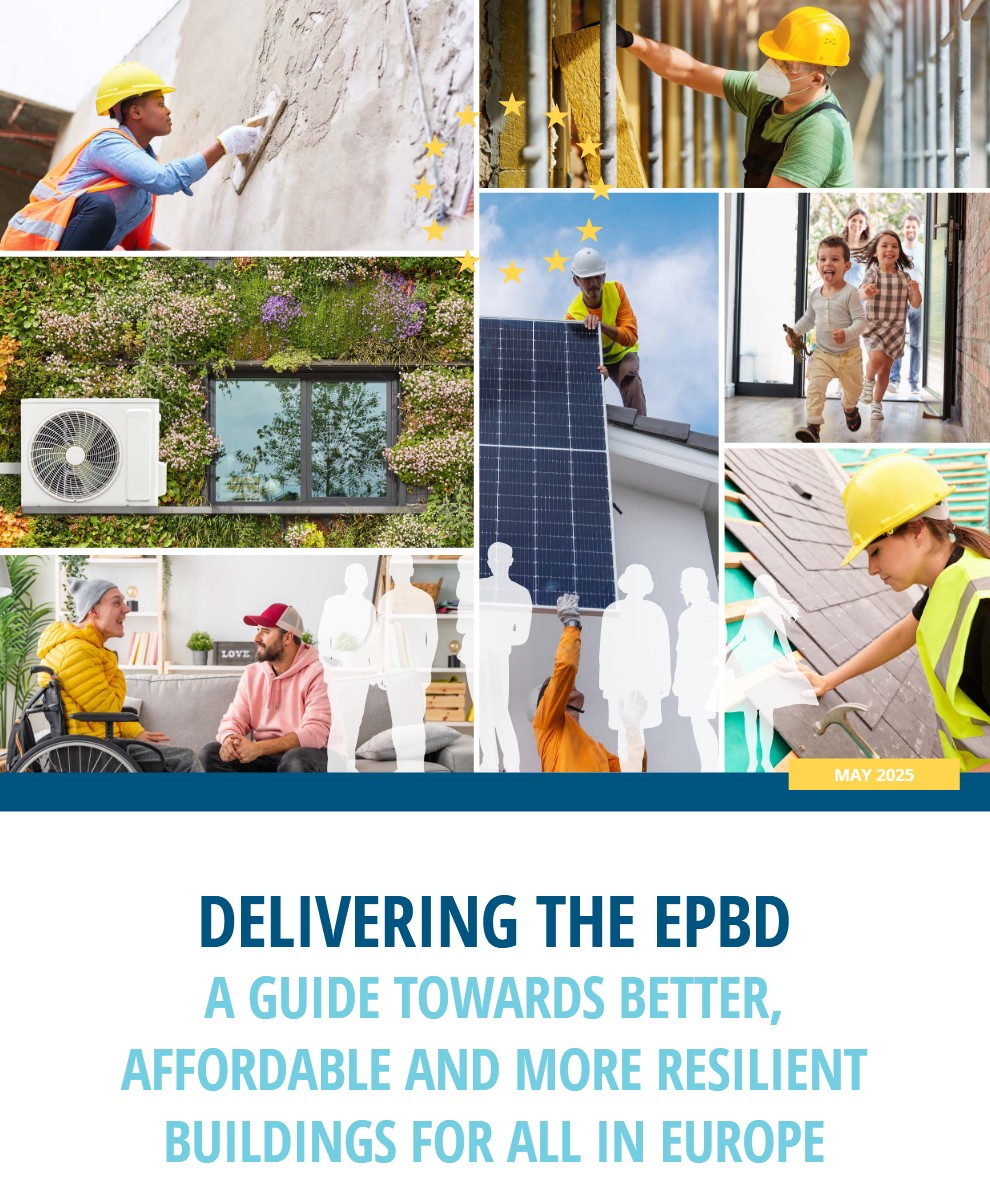




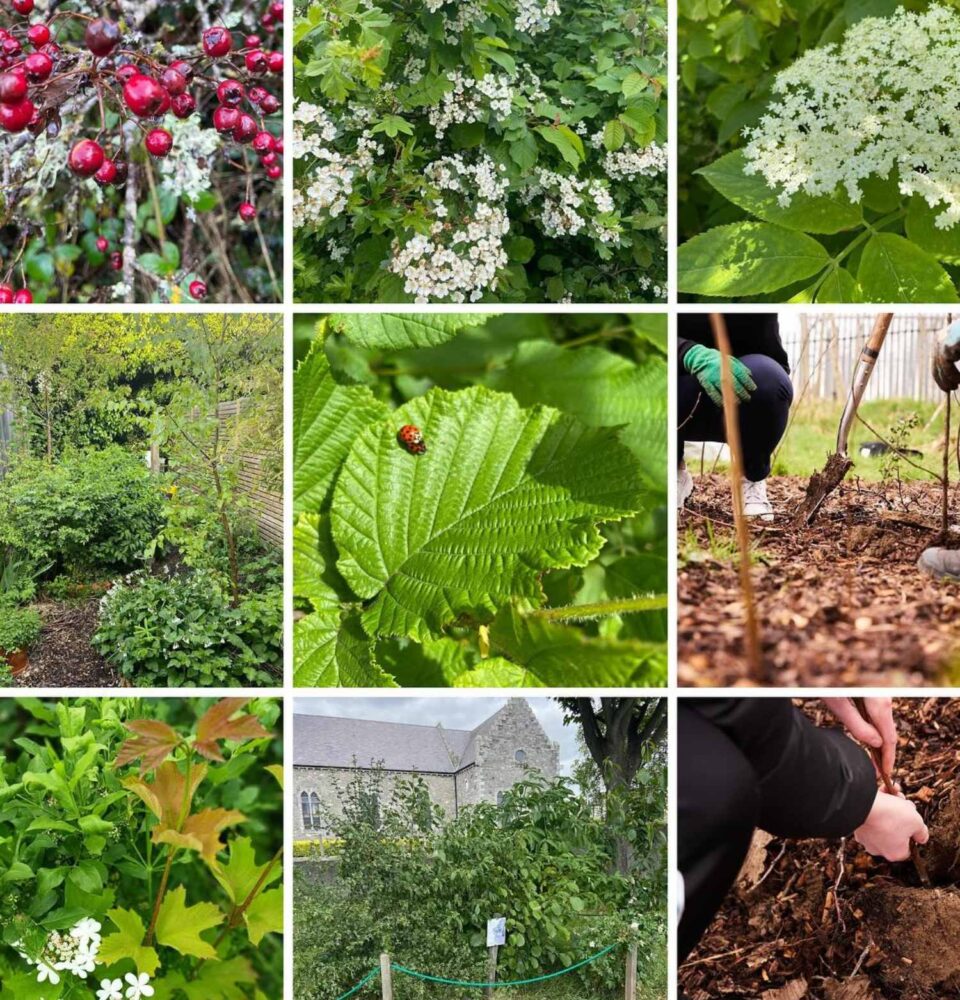







From Refugee Training To The Energy Performance of Buildings Directive And A Newborn Okapi
2 months ago[…] The Energy Performance of Buildings Directive (EPBD): A Game-Changer for European Building Sustainab… […]
Ireland’s Retrofit Race
3 weeks ago[…] Dr Ciaran Byrne C Dir, SEAI […]
Why Nature Credits Matter – With Brian MacSharry, European Environment Agency
4 days ago[…] The Energy Performance of Buildings Directive (EPBD): A Game-Changer for European Building Sustainab… […]